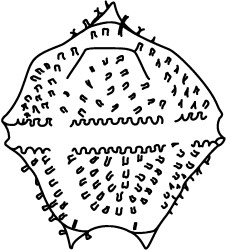Difference between revisions of "Trinovantedinium applanatum"
| Line 14: | Line 14: | ||
|?Category:Type#<nowiki>*</nowiki>, | |?Category:Type#<nowiki>*</nowiki>, | ||
|?Category:TypeCorrectName#<nowiki>+</nowiki>, | |?Category:TypeCorrectName#<nowiki>+</nowiki>, | ||
| − | |limit= | + | |limit=400 |
|format=template | template=SpeciesListNoQuest | |format=template | template=SpeciesListNoQuest | ||
|?Category:Quoted#",''' | |?Category:Quoted#",''' | ||
|Outro=</div>}} | |Outro=</div>}} | ||
Revision as of 16:26, 4 December 2016
+applanatum (Bradford, 1977 [April], p.47-49, fig.2, nos.1-8) Bujak and Davies, 1983, p.163. Holotype: Bradford, 1977, fig.2, nos.1-4. Originally Lejeunia (generic name illegitimate), subsequently Lejeunecysta, thirdly (and now) Trinovantedinium, fourthly Capillicysta. Taxonomic junior synonym: Trinovantedinium capitatum Reid, 1977 (November), by implication in Matsuoka (1984b, p.6), who did not specify priority, and de Verteuil and Norris (1992, p.397-398,408). The nomenclatural type of the genus Trinovantedinium remains the holotype of Trinovantedinium capitatum. Motile equivalent: Protoperidinium pentagonum (Gran, 1902) Balech, 1974, according to Bradford and Wall (1984, p.48-49) and Gu Haifeng et al. (2015, p.49). Age: Holocene.
